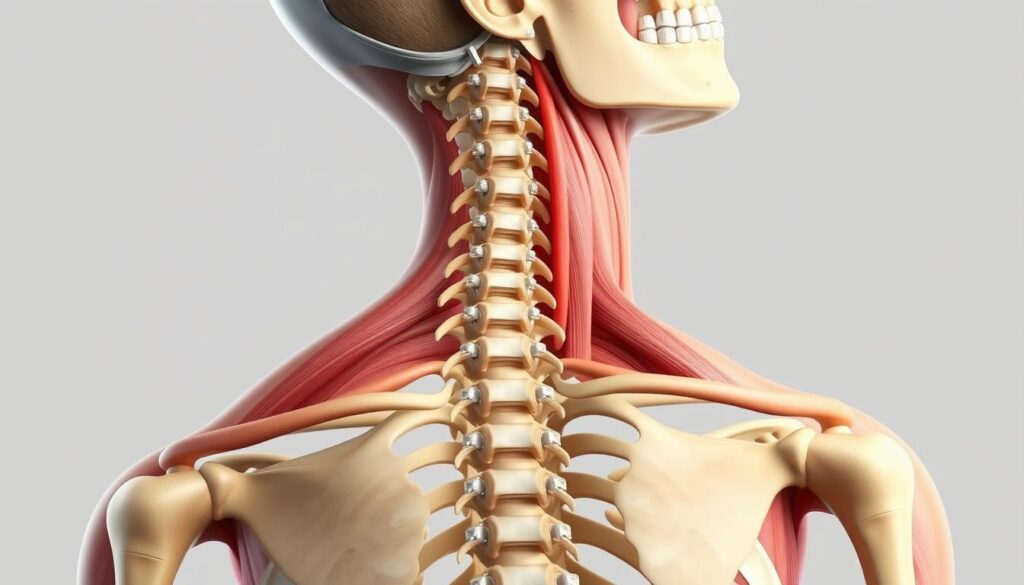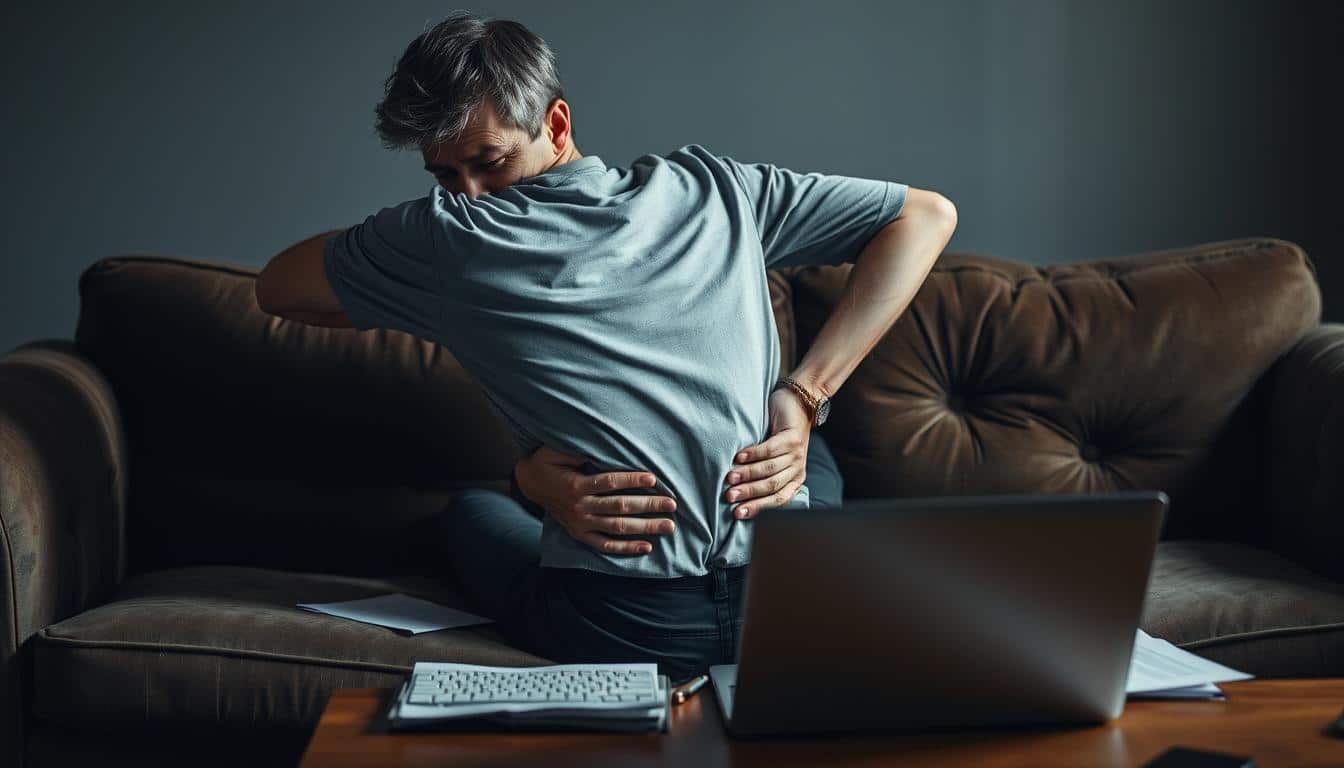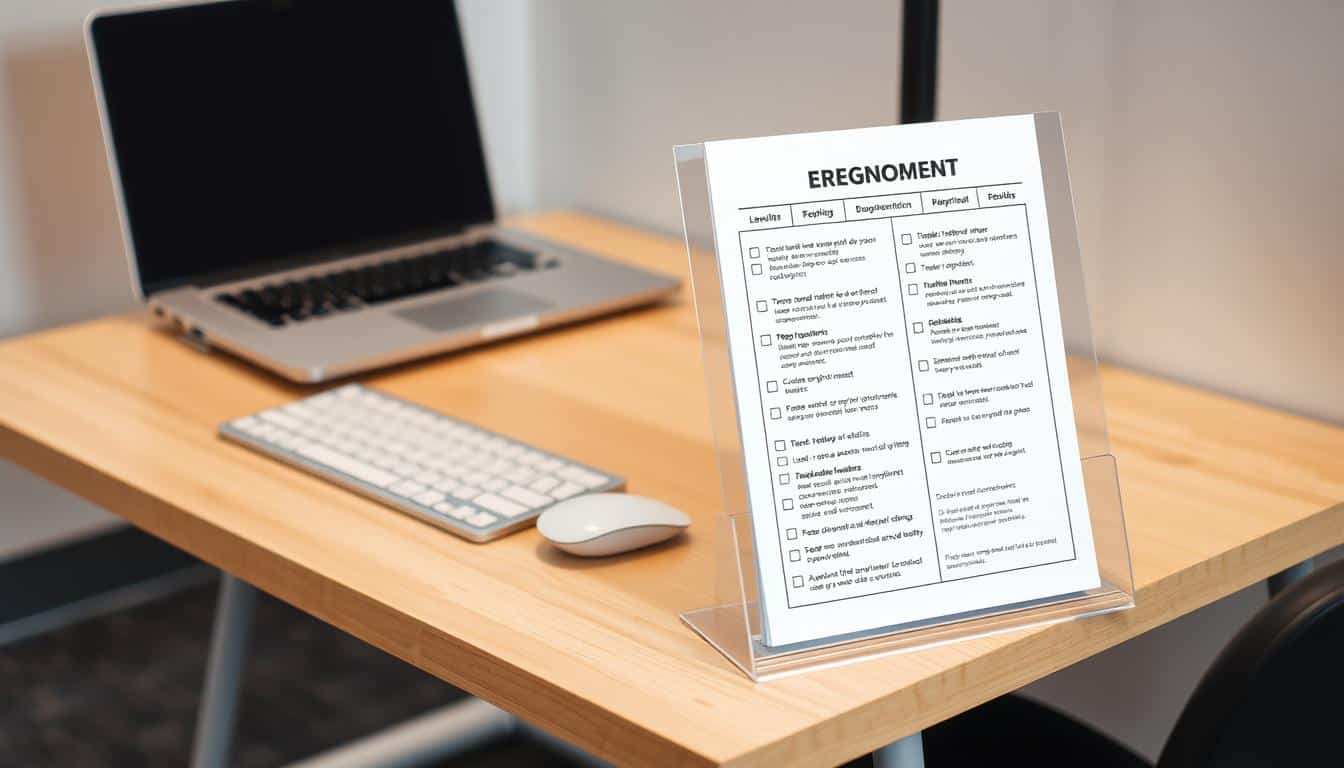Many people today struggle with neck strain because of low monitor setups. This problem, known as tech neck, happens when the workspace does not support proper posture. It’s important to know why neck strain happens and what it feels like. This article will give you useful tips and methods for fixing your posture. By following these steps, you can reduce pain and improve the setup of your workspace.
Understanding Neck Strain and Its Causes
Neck strain, also known as tech neck, happens when we use our neck muscles wrong. This often occurs while using digital devices for too long. We might slouch over our desks or stay on our laptops for hours, making our muscles tired and sore. A lot of people feel this pain because their work areas are not set up right. About 65% of folks working from home say they have neck or back pain, mainly due to bad workstation setups.
Some main reasons for neck strain are:
- Poor posture when sitting at a desk
- Having your monitor too high or low, causing your neck to bend awkwardly
- Using devices too much without taking breaks
- Not having the right furniture and tools that help you work comfortably

Making changes to your workspace can help a lot in solving these problems. Putting your computer screen at the right height and sitting in a good chair can prevent tech neck. When we choose ergonomic ways to set up our work areas, we can stop neck pain from happening. This also helps us work better and feel more comfortable.
Symptoms of Neck Strain From Low Monitor Setup
Knowing when your neck is strained is key to stopping the pain. People working long hours with their screen too low often feel signs of strain. Spotting these early can help stop long-term pain.
Stiffness and Soreness
Neck and shoulder stiffness and soreness are common signs of neck strain. This problem, known as tech neck, comes from staying in bad positions too long. It can make moving your head or lifting things hard.
Persistent Headaches
Headaches often follow neck strain. They usually happen because of muscle stress and not sitting straight. These headaches can really slow you down and make you feel awful.
Numbness and Tingling
If neck strain gets worse, you might feel numbness or tingling in your arms or hands. This happens when your nerves are pinched from staying in one position too long. Knowing these signs early is important to fix the problem fast.
How a Low Monitor Setup Contributes to Neck Strain
Having your monitor too low affects how you hold your head and neck while using a computer. This makes you lean forward, creating a bad neck position that’s not good for your spine. Such a posture puts too much stress on your neck, making it tight and sore.
Staring at a low screen for too long makes things worse. As you keep looking down, your neck feels more pressure. This can lead to constant pain and discomfort. It’s key to have a setup where the screen meets your eye level. This stops the bad posture and pain that come with looking down at your computer for hours.
Importance of Proper Ergonomics in Your Workspace
Setting up an ergonomic workspace is key to staying healthy and productive. Making the right changes can help improve your posture. It also lets you enjoy the perks of a well-set-up space. A good workspace setup helps you have a healthier workday.
Impact on Posture
Good ergonomics play a big part in how you sit. Keeping your spine neutral helps avoid strain. Things that affect your posture include:
- Monitor height and distance
- Chair support and adjustment options
- Keyboard and mouse placement
Tackling these areas helps with better body alignment. It also stops bad posture effects.
Benefits of an Ergonomically Designed Setup
An ergonomic workspace does more than make you comfortable. Benefits include:
- Less chance of musculoskeletal issues
- Better productivity and focus
- Improved overall physical health
Putting effort into an ergonomic setup brings many benefits. It supports both your health and efficiency at work.
Adjusting Screen Height to Reduce Neck Strain
Adjusting your monitor height is key to avoiding neck pain. Make sure the screen is at eye level to keep your neck comfortable. This helps stop the discomfort from long hours at the computer. You can use ergonomic monitors or make a stand yourself to get your screen at the right height.
Using Monitor Stands
A good monitor stand improves your workspace a lot. Ergonomic monitors with adjustable stands let you pick the perfect height. This makes sure you can sit properly and look at the screen without straining. You can find:
- Fixed-height monitor stands
- Height-adjustable stands
- Stands with built-in storage
These options help you adjust your screen and keep your desk tidy.
DIY Solutions for Screen Elevation
If you can’t buy a monitor stand, making one is a cheap choice. Use things around the house to lift your screen to a good height. You can try:
- Stacking books or sturdy boxes
- Using a spare shelf or small tables
- Repurposing old furniture pieces
These homemade stands can greatly enhance your workspace. Raising your screen helps you sit better and reduces neck pain, especially if you work a lot.
Evaluating Your Desk and Chair Setup
Checking your desk setup is key to a comfy and efficient work area. How your desk and chair are set up affects your health, especially your neck. Using an ergonomic chair helps lessen strain by supporting your posture well. Making sure your desk and chair heights match improves how you use your computer.
Chair Features that Support Posture
Look for these important features in an ergonomic chair:
- Adjustable seat height to fit your body size.
- Lumbar support for your lower back.
- Armrests to ease shoulder stress.
- Backrest that keeps your spine straight.
Desk Height Adjustments
To cut down on neck strain, desk height matters. Follow these steps:
- Your desk should let your elbows bend at 90 degrees.
- Position the monitor so it’s level with your eyes, preventing neck tilt.
- Opt for adjustable desks to change height easily.
Regular Breaks and Stretching to Alleviate Neck Strain
Taking regular breaks and doing stretches every day can really help ease neck strain. By moving regularly, you can fix your posture, ease muscle tightness, and feel better. Stepping away from your computer now and then also makes you more productive and comfortable.
Benefits of Movement Throughout the Day
Taking short breaks for some movement is good for your health. The main perks are:
- Better blood flow to your muscles and joints.
- A boost in your energy levels.
- Lower chance of getting injuries from doing the same thing over and over.
Recommended Stretching Exercises
Doing specific stretches helps with the aches that come from sitting too long. Try adding these stretches to your day:
- Neck tilts to gently stretch the sides of your neck.
- Shoulder rolls to ease tightness in your upper back.
- Chest stretches to open up your shoulders and chest area.
Strengthening Exercises for Neck and Upper Back
Adding neck and upper back exercises to your routine is key to easing neck pain. These exercises build muscles that help with good posture. They reduce discomfort and stop other injuries. A regular exercise plan focusing on these areas can greatly help your spine.
Chin Tucks and Shoulder Blade Squeezes
Chin tucks are easy but really helpful. To do a chin tuck, draw your chin down towards your chest without moving your head. Stay like this for a few seconds before letting go. This move makes the muscles at your skull’s base stronger and fixes posture.
Shoulder blade squeezes make your upper back stronger. To do this, sit or stand with your arms down. Pull your shoulder blades together as if you’re holding a pencil between them. Hold for five seconds, then relax. Doing these regularly will help you stand straighter and hurt less.
Implementing a Regular Exercise Routine
To enjoy the benefits of neck and back exercises, you need a workout plan. Try to do these exercises three times a week. Sticking with it strengthens your support muscles and offers long-term neck pain relief.
Mixing these specific exercises with other workouts improves overall health. Think about adding swimming or yoga, which also make the neck and upper back more flexible and strong. By focusing on a complete exercise plan, you’re building a strong base for a healthier life.
Heat and Cold Therapy for Neck Pain
Finding ways to ease neck pain is crucial for those dealing with discomfort. Neck pain relief can significantly improve with heat therapy and cold therapy. These methods each have unique benefits for neck strain. Knowing when and how to use them can speed up recovery and reduce pain.
How to Apply Heat and Cold Effectively
To apply heat therapy, use warm items like compresses, heating pads, or towels on your neck. This helps relax tense muscles and boosts blood flow. Use heat for 15 to 20 minutes, ensuring it’s not too hot to prevent burns.
Cold therapy involves using ice packs or cold compresses to lessen inflammation and numb the area. Use this method quickly after neck strain for the best results. Applying ice for 10 to 15 minutes several times a day is ideal. Always put a cloth between the ice and your skin to avoid frostbite.
When to Use Each Therapy
Begin with cold therapy right after an injury for immediate relief. It helps numb the area and reduce swelling. After the swelling goes down, switch to heat therapy. This change promotes healing and relaxes muscles. Regularly using these therapies can greatly improve neck pain relief.
Seeking Professional Help for Persistent Pain
If you have neck pain that won’t go away, it’s crucial to see a professional. Experts can provide effective relief and better movement. Treatments like chiropractic care adjust the spine to reduce pain and improve posture. Physical therapy gives custom exercises to strengthen your neck and make it more flexible.
Chiropractic Care for Neck Strain
Chiropractors are experts at fixing problems with muscles and bones. They do spinal adjustments to align your spine right, which eases pain and swelling. People often feel their neck move easier and feel better overall. Going to a chiropractor regularly helps keep you healthy, with good posture and less tension.
Physical Therapy Options
Physical therapy helps you get stronger and heal from neck strain. Physical therapists use hands-on care and exercises to help you heal. They make a therapy plan just for you, to improve flexibility and strengthen muscles. This can help fix issues from bad posture. Working with a therapist means getting care that’s tailored to your needs.
Preventive Measures for Avoiding Neck Strain From Low Monitor Setup
To avoid neck strain, start by looking at your workspace and daily habits. Make sure your computer monitor is right at eye level. This helps reduce neck pain. Also, take breaks regularly to let your muscles loosen up, keeping your neck healthy.
Adding exercises that stretch and strengthen your neck and upper back is key. These activities improve muscle strength and flexibility, which cuts down on discomfort. Paying attention to how you sit or stand is crucial for a healthy spine alignment.
- Set your monitor height to eye level to avoid looking down.
- Use an adjustable chair that supports your posture.
- Incorporate short breaks to stand, stretch, and move around.
- Perform neck and upper back exercises daily.
Conclusion
Making your workspace better can help stop neck pain from low monitors. It’s important to adjust your setup to keep your neck healthy. Putting your monitor at eye level is a good start. Make sure your desk and chair help you sit up straight.
Also, taking breaks to stretch can help ease neck tension. If you start feeling sore, it’s key to change things up right away. For ongoing pain, getting advice from a pro can make a big difference.
Choosing the right setup for your work area is a big deal. It helps avoid neck strain. This not only makes you feel better but also boosts your work and life quality.



